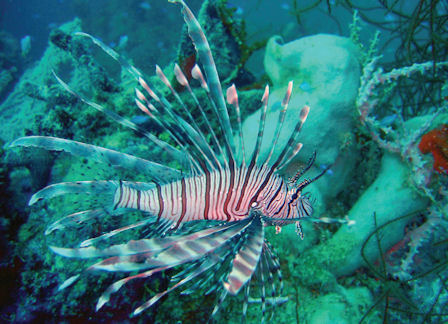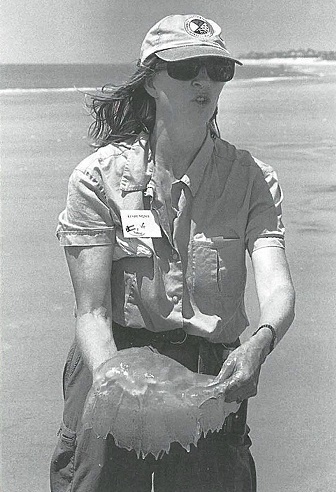ALGAE PATROL: Documenting a Changing Community
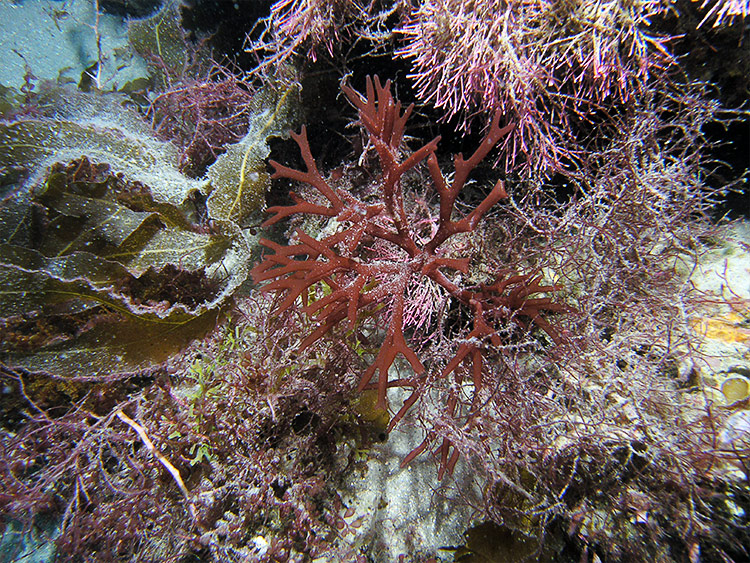
Janna Sasser is a communications intern with North Carolina Sea Grant. She is a senior majoring in communications with a minor in journalism at North Carolina State University.
When Wilson Freshwater began finding new tropical seaweeds off the coast of North Carolina, he had questions.
What is their abundance? What might accompany them? What else does this mean for North Carolina’s coastal waters?
With North Carolina Sea Grant funding a portion of his dives, Freshwater — a marine biologist who specializes in marine algae at the University of North Carolina at Wilmington’s Center for Marine Science — visited three sites in Onslow Bay for seaweed samples.

“Part of my job was to go out and collect them,” Freshwater explains. “At UNCW, we have the capability of doing the deep diving that’s required for this work. One of my areas of expertise is in the identification of marine algae and DNA sequencing.”
With plastic bottles in hand, he and a partner dove 120 to 140 feet to the coral reefs in Onslow Bay to collect macroalgae specimens. When the divers returned to the surface, they quick-dried a small amount of the seaweed to preserve the DNA for analysis.
The rest was handed over to research partners at the National Oceanic and Atmospheric Administration. The NOAA team was sampling for another aspect of the project: the presence of Gambierdiscus.
Gambierdiscus are microscopic marine algae associated with tropical seaweeds. These tropical species are known to produce toxins that can bioaccumulate in fish.
“One of the things Wayne and I were thinking is: There are seaweeds extending their range north along the U.S. coast,” explains Freshwater, referring to Wayne Litaker, a NOAA research biologist. “Gambierdiscus is associated with tropical seaweeds, so as more tropical seaweeds start living offshore here in North Carolina, does that mean there is going to be more Gambierdiscus as well?”
Freshwater provided seaweed samples to Litaker, Steve Kibler and Mark Vandersea — all researchers at NOAA’s Center for Coastal Fisheries and Habitat in Beaufort, N.C. Led by Litaker, the NOAA team tested for the presence of species of Gambierdiscus.
“When the samples would come in, I would take them and culture them,” Kibler explains. “I’d look for the cells and establish cultures from them, and also give some material to the molecular biologists to look at which species were present.”
Vandersea would then use molecular-level testing to survey which Gambierdiscus species were present on the seaweeds.
By documenting the diversity and abundance of tropical seaweeds and Gambierdiscus species in North Carolina, and identifying if these cells are associated with certain seaweeds, Freshwater and NOAA colleagues are establishing preliminary data for future work.
As the ocean is expected to continue to warm, these data will allow researchers to compare the future abundance of Gambierdiscus to current levels, and to assess the potential impact of the toxins it produces.
Rising Temperatures, Migrating Species
Litaker, who specializes in the study of harmful algal blooms, began surveying North Carolina’s reefs for Gambierdiscus in 2004. He and colleague Pat Tester piggybacked their research needs onto NOAA’s annual cruises that were surveying various offshore locations for lionfish, an invasive species native to Pacific waters. This was an opportune time to look more closely at North Carolina’s reefs.
From those early samples, Litaker and Tester found Gambierdiscus cells attached to the macroalgae. Their 2009 report is the first evidence of these cells in North Carolina waters. They also reported a new species, Gambierdiscus carolinianus — named for its discovery site in North Carolina.
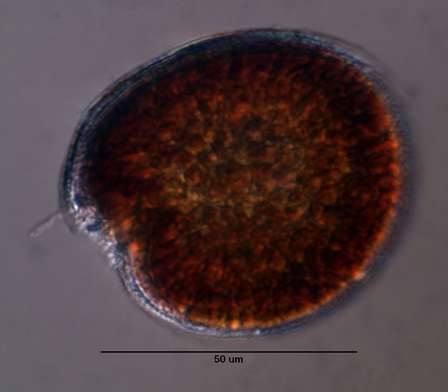
“We consider them sentinel species for climate change,” Litaker says, noting that these organisms prefer warmer water.
As ocean temperatures rise, tropical species, including some that are considered invasive, are migrating northward into nonnative areas, including off the North Carolina coast. A few degrees of change in water temperatures can dramatically shift the distribution of coastal organisms such as fish, invertebrates and macroalgae.
The lionfish invasion grabbed public attention, but lionfish were just part of the story. Tropical macroalgae have begun to follow. Species of tropical seaweeds have been found in North Carolina’s waters in the past two decades.
And sometimes, Gambierdiscus shows up with the seaweeds. These warm-water microalgae are epiphytes — attaching themselves to seaweeds for physical support.
“What we thought we would do,” Litaker explains, “is start this survey with Wilson to document things like ‘Are the cells present? And ‘At what sort of concentrations?’ so we could have a baseline for future work.”
Along with documenting the abundance of tropical seaweed and Gambierdiscus populations within Onslow Bay, the researchers also wanted to establish if the microalgae have a preference for certain species of seaweeds.
“No one has a good idea if they really associate with particular species,” Freshwater explains, noting that his goal was to collect multiple seaweeds to test for different Gambierdiscus species.
By understanding the association with seaweeds, as tropical seaweeds become more abundant in North Carolina’s waters, researchers will be able to better assess increases in Gambierdiscus growth and abundance.
Revisiting, Re-examining
The Sea Grant funding enabled Freshwater to revisit three Onslow Bay sites previously surveyed by NOAA where Gambierdiscus was initially found.
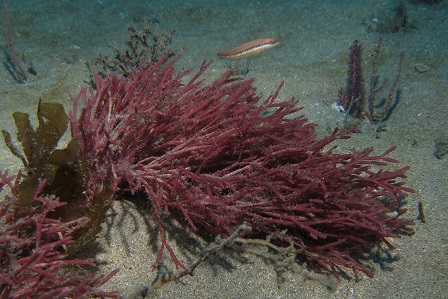
The 2014 samples revealed that Gambierdiscus cells still were present. However, Freshwater returned with other significant data.
At two of the sites, Freshwater retrieved NOAA temperature loggers left since 2010 during the annual lionfish cruises. The devices showed water temperatures during winter still are too cold for Gambierdiscus to reach high levels of abundance.
“Using lab experiments, we figured out the temperature thresholds for the cells that allow them to grow, prevent them from growing or in-between — to allow them to grow, but very slowly,” Kibler notes of his previous Gambierdiscus research, published in 2012.
By using this threshold, the researchers were able to determine that current North Carolina wintertime temperatures limited Gambierdiscus growth.
“What that means locally,” Kibler adds, “is that temperatures in the winter are cold enough that they keep the abundance of Gambierdiscus very low in this area.”
This data can be used to predict how the abundance of the cells might be affected by changing water temperatures.
However, abundance is only a factor in the potential risk these microalgae bring to the area. An increase in abundance also could mean a growing flux of toxins entering the local food web.
Assessing a Risk
Gambierdiscus species produce ciguatoxins. Though harmless to fish, ciguatera toxin is poisonous to humans. Consumption of toxin-laced fish causes ciguatera fish poisoning, or CFP.
The illness causes severe gastrointestinal and neurologic symptoms such as vomiting, weakness, dizziness, numbness and, in some cases, death.
Though CFP is the most prevalent nonbacterial cause of seafood poisoning in the world, it is commonly considered to be a tropical illness.
In the United States, CFP cases usually are associated with consumption of fish imported from ciguatera-endemic regions in the tropics or with consumption of contaminated fish by tourists traveling overseas.
In the Atlantic, CFP has been most common in portions of the Caribbean and Gulf of Mexico, where coastal water temperatures are generally higher than those in North Carolina.
However, water temperatures are expected to continue inching upward and the waters are warming. Kibler’s recent work predicts that in 20 or 30 years, North Carolina’s oceanic climate will be more like conditions currently farther south, such as the coasts of Florida and the Gulf of Mexico.
For much of the United States, including North Carolina, locally sourced fish have been considered safe. But as North Carolina’s oceanic climate becomes more tropical, there is an increasing risk of CFP in the state’s waters.
“We can predict how the abundance of Gambierdiscus cells might change based on temperature, but we don’t know anything about toxicity,” Kibler says. “We can’t go that far with it.”
Kibler explains that the Sea Grant study shows that although there are several species of potentially toxic Gambierdiscus that occur locally, the threat for CFP is low. “There’s just not enough cells around to be much of a threat right now,” he adds.
With a baseline for the threat of CFP established, the researchers hope this question will be revisited in the future to determine if abundances have changed.
Looking Ahead
Freshwater continues to look for new seaweeds that are expanding their ranges into North Carolina’s waters. He also hopes to keep using temperature loggers to track ocean warming.
Most of the current Gambierdiscus research done by Litaker, Kibler and NOAA co-workers has been in the Caribbean, Gulf of Mexico and tropical Pacific. They also are collaborating with partners in France, French Polynesia, New Zealand and Australia.
“We’re trying to understand several things,” Litaker explains. These include confirming which Gambierdiscus species are toxic, their level of toxicity and their distribution in the environment. The group also is trying to use models to predict the risk of CFP, along with developing better techniques of measuring the toxin itself.
He explains that by looking south, they can better address what might be headed north in the future.
“It’s only now just the beginning,” Litaker says. “The fish and algae have been leading it. You’re finding more and more tropical fish and macroalgae in North Carolina, so essentially what we’re seeing is a gradual shift to a different type of community — one which may contain more toxic species.”
Read the three other stories in this series
- Minigrants: Fast, Simple, Noteworthy
John Fear highlights the strengths of the minigrant program. - Jellyfish in Bloom: Are Humans Contributing to Local Populations?
Scientists test Atlantic sea nettles’ preference for man-made and natural surfaces. - Fishing for Funding
A minigrant helped a North Carolina business test an alternative crab bait.
This article was published in the Holiday 2015 issue of Coastwatch.
For contact information and reprint requests, visit ncseagrant.ncsu.edu/coastwatch/contact/.
- Categories:
